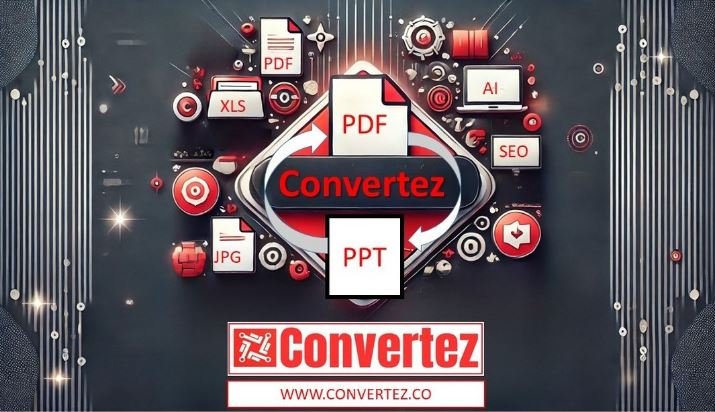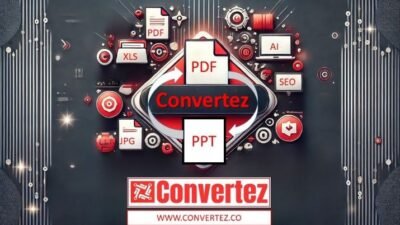In today’s fast-paced digital world, effective communication is key—especially when it comes to presenting ideas. Whether you’re a student, teacher, business professional, or designer, chances are you’ve worked with PDF files and PowerPoint presentations. While PDFs are ideal for preserving layouts and sharing content, PowerPoint (PPT) is the go-to tool for engaging presentations thanks to its dynamic features, including PDF to PowerPoint with Animations with Animations and transitions.
But what if your content is locked in a PDF, and you want to create an animated, interactive slideshow? Good news—you can convert a PDF to PowerPoint with Animations and then bring it to life with animations. In this blog post, we’ll explore how to do it, the tools you can use, best practices, and tips to ensure your animated PowerPoint stands out.
Why Convert PDF to PowerPoint with Animations?
Before diving into the “how,” let’s understand the “why.” PDFs are great for documents, brochures, and reports. However, they are static. If you’re presenting to an audience, static content might not hold their attention. PowerPoint allows you to:
- Add animations to text and graphics
- Apply transitions between slides
- Insert videos, audio, and hyperlinks
- Customize themes and templates
- Collaborate in real-time
Converting your PDF content to PPT gives you the flexibility to repurpose the information into a compelling, animated presentation.
Step 1: Convert PDF to PowerPoint with Animations
There are several ways to convert a PDF to a PowerPoint file:
1. Online PDF to PowerPoint with Animations Converters
Free and premium online tools make the process simple. Some reliable converters include:
- Convertez PDF to PPT Tool – Fast, secure, and user-friendly.
- Adobe Acrobat Online
- SmallPDF
- ILovePDF
- PDF2Go
How to use:
- Go to the converter website.
- Upload your PDF file.
- Click “Convert.”
- Download the PowerPoint (.pptx) file.
These tools preserve the layout and formatting quite well, but animation features won’t be included yet—you’ll add those manually in the next steps.
2. Use Adobe Acrobat Pro
If you have a paid subscription to Adobe Acrobat Pro, you can export your PDF directly to PowerPoint:
- Open your PDF in Acrobat Pro.
- Click on “Export PDF” from the right-hand panel.
- Choose “Microsoft PowerPoint.”
- Click “Export,” and save your new PPTX file.
This method provides better control over formatting and typically yields higher quality results.
Step 2: Add PDF to PowerPoint with Animations to Your Slides
Once you’ve converted your PDF to PowerPoint, the next step is bringing it to life with animations. This is where the real magic happens.
Types of PDF to PowerPoint with Animations
- Entrance animations – Objects appear on the slide.
- Emphasis animations – Objects already on the slide move or change to grab attention.
- Exit animations – Objects disappear or move off the slide.
- Motion paths – Objects move along a defined path.
How to Add PDF to PowerPoint with Animations
- Open your converted PowerPoint file.
- Select the object (text box, image, shape) you want to animate.
- Go to the Animations tab in the ribbon.
- Choose an animation effect from the gallery.
- Customize the animation using the Animation Pane (timing, delay, trigger).
You can apply multiple animations to one object, combine different types, and adjust the order of appearance using the Reorder Animations function.
Pro Tip: Avoid overusing animations. Stick to a consistent style and only use animations when they enhance clarity or impact.
Step 3: Add Slide Transitions
PDF to PowerPoint with Animations are for objects within a slide. Transitions are used between slides to create smooth flow from one to the next.
To add transitions:
- Click on the slide thumbnail in the left panel.
- Go to the Transitions tab.
- Choose a transition effect (e.g., Fade, Push, Wipe).
- Use the Duration and Timing options to fine-tune the effect.
Keep it simple—don’t use different transitions on every slide. A consistent transition style keeps your presentation professional.

Step 4: Enhance Your Slides with Multimedia
Now that your basic PDF to PowerPoint with Animations are in place, think about adding:
- Audio narration – Great for self-running presentations.
- Background music – Adds a professional touch if done subtly.
- Video clips – Demonstrate a product, tutorial, or case study.
- Hyperlinks – Add navigation or references.
Use the Insert tab in PowerPoint to embed these multimedia elements. Ensure your file sizes are manageable, especially if you plan to share the presentation online.
Step 5: Review and Polish
Once you’ve animated your presentation:
- Preview all slides using the Slide Show mode.
- Use the Animation Pane to review sequence and timing.
- Check for spelling errors and formatting issues.
- Save the final version as a PowerPoint or export it as a video or PDF with transitions (yes, you can create animated PDFs too!).
Bonus: Tools to Automate PDF to PowerPoint with Animations
If you want to streamline the animation process, consider tools like:
- PowerPoint Designer (Windows 365) – Offers layout and animation suggestions.
- Presentation AI tools – Some AI-based platforms generate animated slides based on uploaded content.
- Templates – Websites like Envato Elements or Canva offer ready-made animated PowerPoint templates.
Common Use Cases
Here are a few practical scenarios where converting PDF to animated PowerPoint is helpful:
- Educational Lectures – Convert a textbook chapter into a visual slideshow.
- Business Reports – Turn a static report PDF into a dynamic boardroom presentation.
- Marketing Pitches – Add energy and storytelling to proposals.
- Training Material – Make employee manuals more engaging.
Final Thoughts
Converting PDF to PowerPoint with Animations bridges the gap between static content and engaging storytelling. While the conversion process is simple, the magic lies in how creatively you add animations, transitions, and multimedia elements.
By following the steps above, you can transform dull documents into visually rich presentations that captivate and inform your audience. So next time you have a PDF report or guide—don’t just send it.

